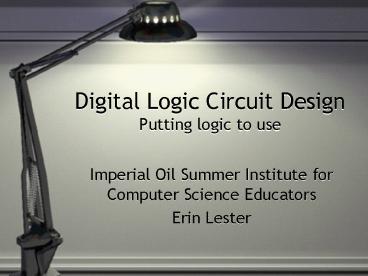Digital Logic Circuit Design Putting logic to use - PowerPoint PPT Presentation
1 / 19
Title:
Digital Logic Circuit Design Putting logic to use
Description:
Digital Design. When studying combinational circuits, the circuit comes before the truth table ... want to design an electronic circuit for a 2-person voting ... – PowerPoint PPT presentation
Number of Views:190
Avg rating:3.0/5.0
Title: Digital Logic Circuit Design Putting logic to use
1
Digital Logic Circuit DesignPutting logic to use
- Imperial Oil Summer Institute for Computer
Science Educators - Erin Lester
2
Introduction
- So you know and love the fundamental logic gates
- But why do you know them? How are they used in
real life?
3
Digital Design
- When studying combinational circuits, the circuit
comes before the truth table - But this is backwards to reality
- In circuit design, we develop a truth table and
then use it to determine the circuit needed
4
The Design Process
- Suppose you want to design an electronic circuit
for a 2-person voting system that determines if
the majority of the votes are yes - How do you go about this?
- What steps are involved?
5
Step 1 Declaring Variables
- When working with digital logic we must use
Boolean values (on/off or 0/1) - The first step is to model the systems inputs
and outputs as Boolean values - The 2 vote inputs can be modeled as yes/no values
A and B - The output, which represents a majority yes
scenario, can be modeled as Y
6
Step 2 Determine the Truth Table
- The next step is to determine the truth table -
that is, what combinations of inputs make our
output(s) true (i.e. 1) - In our case the truth table is as follows
7
Two different versions of the truth table
8
Step 3 Simplification
- Logic functions derived from a truth table can be
very complex - The Boolean logic functions derived are called
minterm expressions - These functions are the sum of products of
Boolean variables e.g.
9
Simplification continued
- For example, suppose that instead we wanted our
output to be on (e.g. true) if either voters
either agree or disagree(that is there isa
consensus)
10
Simplification continued
- In this case our Boolean expression would be
- The 2 values added (that is ored) together
correspond to the expressions for the rows in the
truth table with 1s - These expressions are called minterms
11
Simplification continued
- Minterm expressions can be simplified using
Boolean Algebra Laws or Karnaugh Maps (Kmaps) - For example, the expressionsimplifies to
- This is because it is true only in all of the
cases when B is true
12
Simplification continued
- Complex Boolean expression simplification can
also be done using software - Simple Kmap programs exist as well
- Advantages to simplification include economics,
clarity and aesthetics
13
Step 4 Create the circuit
- At this point you are ready to create your
circuit using logic chips and input/output
components - For the voting system
- inputs can be simple solid state, on/off switches
- the logic is a single AND gate (74LS08 IC)
- inputs and outputs can be shown with LEDs
14
Creating the circuit
- You could have students build their circuits into
a working model - Ideas include traffic light systems, voting
systems, games, alarm/sensor systems
15
Your Turn
- In a group of 2-4 people, design the logic
circuit for one of the following - A 2 person voting system with 3 outputs majority
for, against and tie - A 3 person voting system with 2 outputs for and
against - A walk signal for a standard traffic light
- A circuit that compares two 2-bit values and
outputs if they are the same
16
Boolean Algebra Laws
- And Laws
- A1A
- A00
- AAA
- AA0
- ABBA
- (AB)CA(BC)
- A(BC)(AB)(AC)
- (AB)AB
- Or Laws
- A11
- A00
- AAA
- AA1
- ABBA
- (AB)CA(BC)
- A(BC)(AB)(AC)
- (AB)AB
Show that A B A B A
17
Design Resources
- Reid, Neal E. and Wilson, Stanley L. Computer
Science Program Design and Technology. Toronto
John Wiley Sons, 1985, pp 334-365.
18
Minterm Resources
- Minterms http//doyle.wcdsb.ca/ICE4MI/digitial_el
ectronics/minterms.htm - Simplification with Karnaugh maps ( minterms)
http//doyle.wcdsb.ca/ICE4MI/digitial_electronics/
karnaugh_maps.htm - Karnaugh map explorer http//doyle.wcdsb.ca/ICE4M
I/digitial_electronics/KarnaughExplorer.htm
19
Boolean Algebra Resources
- Boolean algebra laws http//doyle.wcdsb.ca/ICE4MI
/digitial_electronics/boolean_algebra_laws.htm - Boolean algebra simplification
http//doyle.wcdsb.ca/ICE4MI/digitial_electronics/
boolean_simplification.htm - Logic gate simulator http//doyle.wcdsb.ca/ICE4MI
/LearnAndOrNot/index.html































